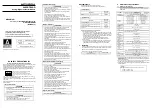
27
It is a good rule to carry out periodic checks in order to verify the proper operation of the unit.
OPERATION
1 month 4
6 month
Charging the water circuit.
x
Presence of bubbles in the water circuit.
x
Check if the safety and control devices work correctly
x
Check if there is oil leakage from compressor.
x
Check if there is water leakage from the hydraulic circuit.
x
Check the proper working of the flow switches.
x
Check that the crankcase electric heaters are properly supplied and functioning.
x
Clean the metallic filters of the hydraulic circuit.
x
Clean the finned coil by means of compressed air or water jet.
x
Check if all the terminals on the electric board as well as on the terminals of the compressor are
properly fixed.
x
Check the tightening of water connections.
x
Check the tightening and the balancing of the fan blades.
x
If the voltage is correct.
x
Check the Correct absorption.
x
Check the refrigerant charge.
x
Check the operating pressure, and superheat and sub-cooling
x
Check of the efficiency of circulation pump.
x
Check the expansion tank.
x
If the unit should be out of service for a long period, discharge water from the piping and from heat
exchanger. This operation is necessary if, during seasonal stoppages, ambient temperature is
expected to go down below the freezing point of the employed fluid.
x
11.1
CLEANING OF THE FINNED CONDENSER
It is important to follow the instructions below in order to perform a proper cleaning:
a) Remove dirt from the surface. Deposits like leaves, fibers, etc. must be removed using a vacuum cleaner (use a brush or other
soft accessory, be careful to avoid rubbing with metal or abrasive parts). In case of using compressed air, it is necessary to pay
attention to keep the air flow always perpendicular to the surface of the condenser to avoid bending the aluminum fins. Be careful
not to bend the fins with the nozzle of the compressed air lance.
b) Rinse with water. It is possible to use chemical substances (specific detergents for finned condensers). Rinse by do running the
water inside each single passage of the fins, until they are perfectly clean. Be careful to direct the water jet perpendicular to the
surface of the condenser for not to bend the aluminum fins. Avoid hitting the condenser with the water hose. It is recommended
not to place your thumb on the end of the rubber pipe to obtain the desired pressure of water jet instead of using special nozzles
that could hit the condenser and damage it.
WARNING: Do not use pressure washers for the cleaning of the heat exchanger in order to prevent excessive pressure from
creating irreparable damage. Damages caused by cleaning using high water pressure washers or unsuitable chemical substances
will not be recognized.
WARNING: The aluminum fins are thin and sharp. Be very careful to use special PPE to avoid cuts and abrasions. Properly protect
your eyes and face to avoid splashing water and dirt during blowing. Wear waterproof shoes or boots and clothing that covers all
parts of the body.
For units installed in an aggressive atmosphere with a high fouling rate, cleaning the battery must be part of the ordinary
maintenance program. On this type of installation, all the dust and particulates deposited on the batteries must be removed as
soon as possible by periodic cleaning following the procedures described above.
11.2
EXTRAORDINARY MAINTENANCE
Any work of extraordinary maintenance must be carried out by authorized service center.
11.3
ENVIRONMENTAL PROTECTION
According to the norms dealing with the use of depleting stratospheric ozone substances, it is forbidden to disperse refrigerants
fluids in the atmosphere. They have to be collected and delivered to the seller or to proper gathering points at the end of their
operating life. Refrigerant R410A is mentioned among controlled substances and for this reason it has to be subjected to the
mentioned norms.
A particular care is recommended during service operations in order to reduce as much as possible any
refrigerant loss.
12
DISPOSAL OF THE UNIT
Once the unit is arrived at the end of its life cycle and needs to be removed or replaced, the following operations are
recommended:
• The refrigerant has to be recovered by trained people and sent to proper collecting centre.
•
Any non-freezing solutions added to the hydraulic circuit must be recovered and properly disposed.
• Compressors’ lubricating oil has to be collected and sent to proper collecting centre.














































